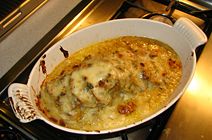Veal Orloff
Veal Orloff, also called Veal Prince Orloff, Veal Orlov, or Veal Prince Orlov, is a 19th-century French-Russian dish of unclear origin but, in its original form, still a lasting symbol of classical French haute cuisine. In its most elaborate form, a saddle of veal (also called a double loin of veal) was roasted or braised. Its two cylindrical pieces of meat were then carefully removed from the bones and cut into uniform slices. The slices were then layered with a soubise, a thick purée of cooked onions and rice, and with a duxelles, chopped, cooked mushrooms, then put back into the bones and covered with either a mornay or béchamel sauce. It was then sprinkled with cheese and reheated and browned in the oven before being served.
The most common story relating to its origin is that Urbain Dubois, a 19th-century French chef, named it in honor of his employer, a certain Prince Orloff, a former Russian ambassador to France. Others say that it was created by the earlier, but even more famous Marie-Antoine Carême, "the king of chefs, and the chef of kings". A third story credits it to an earlier-still French chef laboring in Russia for a Prince Grigoryevich Orlov, a one-time lover of Catherine the Great. Some of these stories go on to say the person for whom the dish was created actively disliked veal and that the rich sauces were a means of masking the true nature of the meat. Whatever the true story, it was undoubtedly first served in the days before refrigeration and it is quite possible that its composition was designed to mask somewhat spoiled meat. It is also said by some sources that veal Orloff was never served in Russia until fairly recently.
Many less complicated dishes bearing the same name appeared in the 20th century. In the simplest form, which can still be found in contemporary restaurants, they consist of a cooked veal cutlet or chop being covered with mushrooms and/or a soubise, then with mornay or béchamel sauce, and then being briefly browned in the oven or under a broiler. In the 1960s a somewhat simplified version of the original dish was popularized by Julia Child and became a standard dinner-party centerpiece for a certain class of Americans, along with other French dishes such as beef Wellington, chicken Kiev, coq au vin, and steak au poivre.[1]



